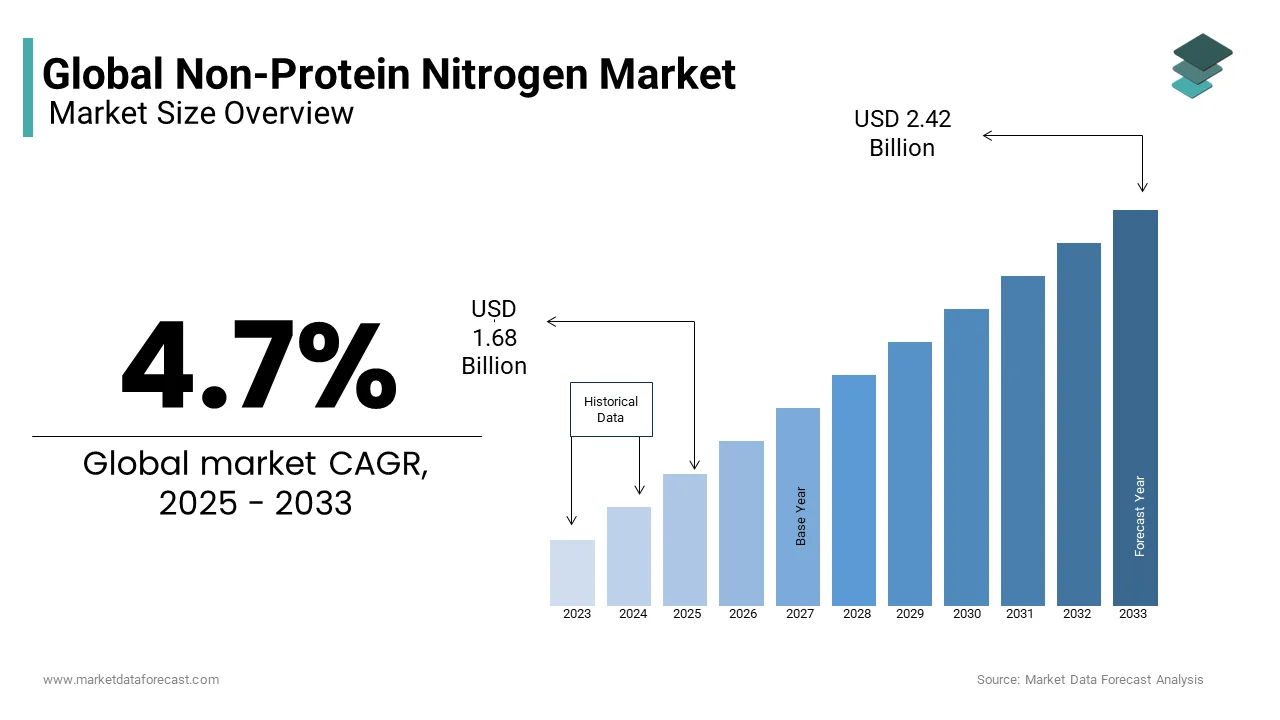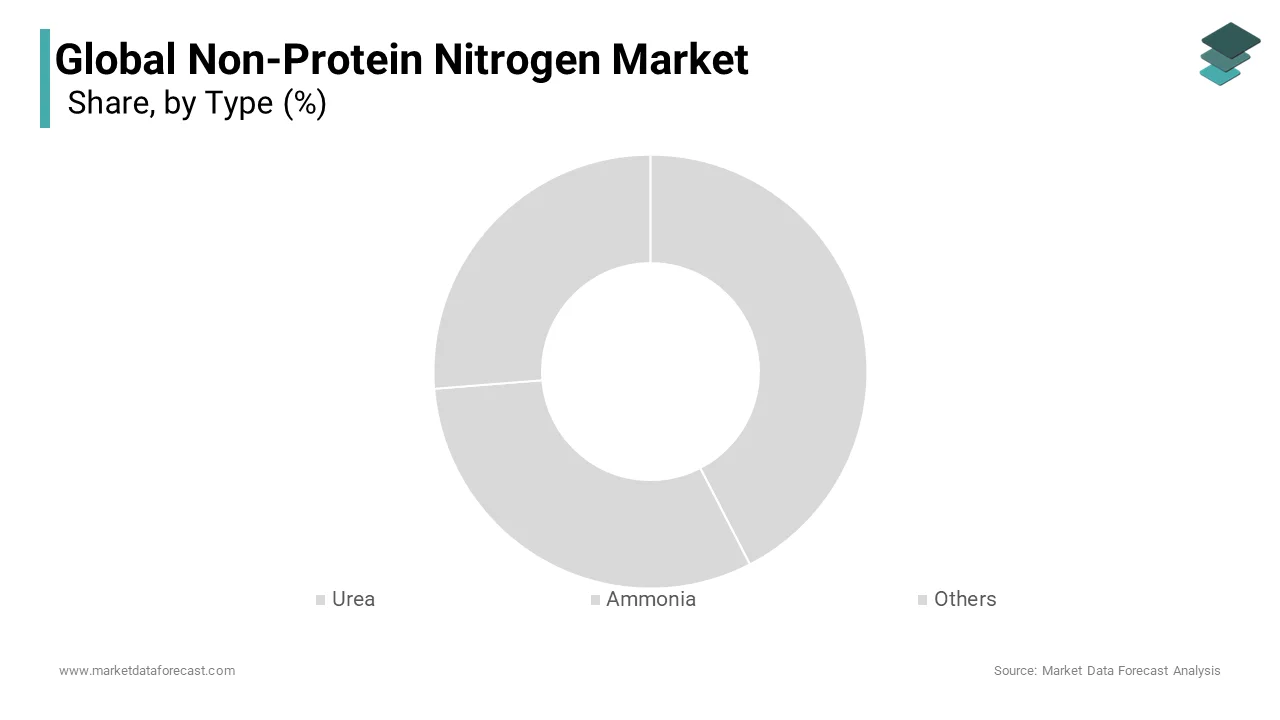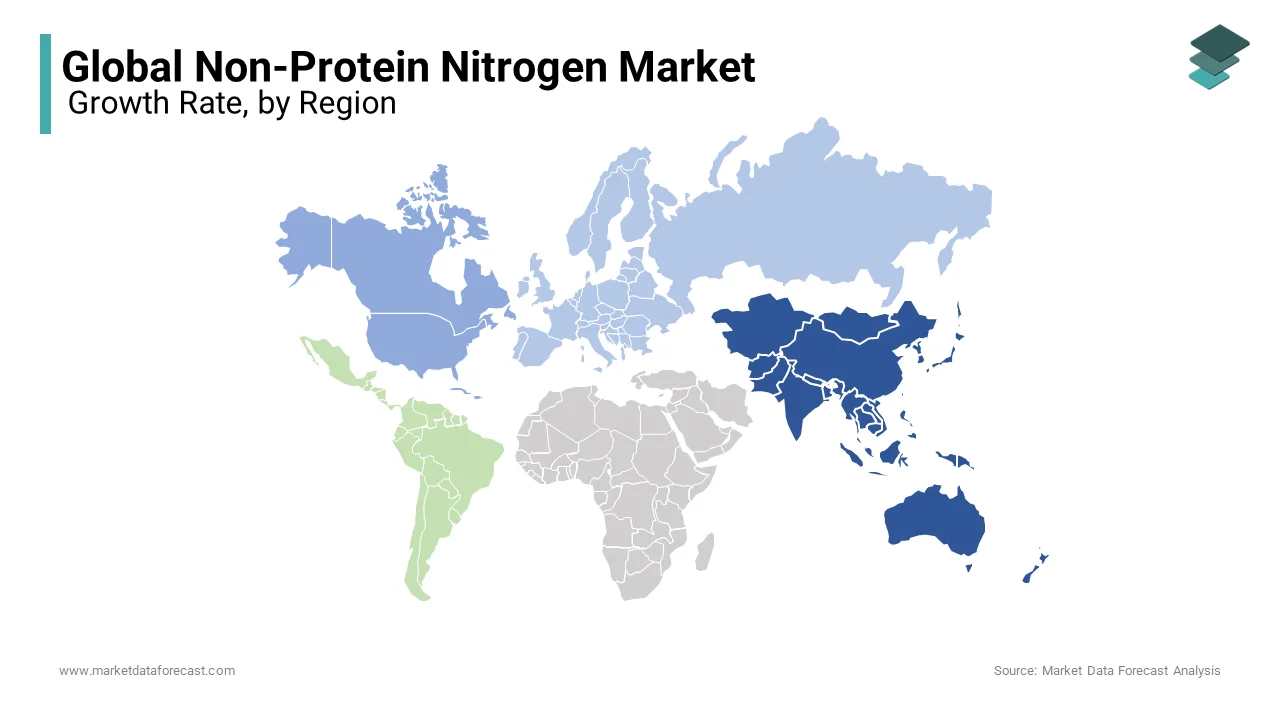Global Non-Protein Nitrogen Market Size, Share, Trends & Growth Forecast Report, Segmented By Type (Urea, Ammonia and Others), Form (Dry, Liquid and Pellet), Livestock (Swine, Poultry, Cattle, Aquaculture and Other Livestock) and Region (North America, Europe, Asia – Pacific, Latin America, Middle East and Africa), Industry Analysis From 2025 to 2033
Global Non-Protein Nitrogen Market Size
The global non-protein nitrogen market was valued at USD 1.60 billion in 2024 and is anticipated to reach USD 1.68 billion in 2025 from USD 2.42 billion by 2033, growing at a CAGR of 4.7% during the forecast period from 2025 to 2033.

The global non-protein nitrogen (NPN) market is thriving because of the rising demand for livestock products. As the demand for meat, milk, and other livestock-derived products rises, the necessity for efficient and cost-effective animal nutrition becomes an important need. Non-protein nitrogen sources, which include urea and ammonia, have emerged as indispensable supplements to traditional protein feeds such as soybean meal and fishmeal. These NPN sources offer an economical means to bolster animal nutrition, enhance livestock growth, and optimize feed efficiency. With the market's trajectory closely aligned with the expanding livestock industry, NPN's role in meeting the nutritional demands of animals is more crucial. Moreover, its sustainable attributes contribute to environmentally responsible livestock production practices. As the global appetite for livestock products shows no signs of abating, the Non-Protein Nitrogen market is poised for sustained growth, underpinned by its cost-effectiveness and critical role in supporting livestock growth and productivity.
The Non-Protein Nitrogen (NPN) market is witnessing growth in its cost-effectiveness. Compared to traditional protein feeds like soybean meal and fishmeal, NPN sources, including urea and ammonia, are notably more economical. This cost-efficiency holds immense appeal for livestock farmers striving to balance the equation of quality nutrition and economic feasibility. Livestock production can be a resource-intensive endeavor, and feed costs often constitute a significant portion of the overall expenditure. Non-protein nitrogen sources present a viable solution, allowing farmers to optimize their feed budgets without compromising animal health or productivity. As a result, the Non-Protein Nitrogen market continues to flourish as a practical and cost-effective choice, offering livestock farmers a means to meet the nutritional requirements of their animals while ensuring the economic viability of their operations.
MARKET RESTRAINTS
Safety concerns are a substantial restraint in the Non-Protein Nitrogen (NPN) market. Mishandling and overuse of NPN sources pose significant risks to animal health. Urea toxicity can occur if not used judiciously, leading to a range of health problems in livestock. In this context, ensuring the safe handling and precise dosages of NPN sources is not merely a recommendation but an imperative. Livestock farmers must be well-informed about the correct application of these products to prevent unintended harm. This necessitates robust education and training within the industry to raise awareness about the potential dangers associated with improper use. Safety concerns are not only essential for animal welfare but also for maintaining consumer confidence in the livestock industry. Thus, safety remains a fundamental challenge that the NPN market must address conscientiously to ensure the well-being of animals and the sustainability of the industry.
Impact Of COVID-19 On The Global Non-Protein Nitrogen (NPN) Market
The COVID-19 pandemic had both detrimental and advantageous effects on the Non-Protein Nitrogen (NPN) market, as the disruption of supply chains and restrictions on movement led to logistical challenges in sourcing and distributing NPN products. The uncertainties surrounding the pandemic also affected the economic stability of livestock farmers, potentially reducing their ability to invest in supplementary feed. Additionally, reduced production capacities and labor shortages in some regions could have hampered the manufacturing and distribution of NPN sources. However, the NPN market demonstrated resilience during the pandemic, primarily due to its cost-effectiveness. As the economic impact of COVID-19 prompted farmers to seek more affordable livestock feed options, NPN sources gained favor as an economical means of ensuring animal nutrition. Furthermore, NPN's sustainable characteristics contributed to its continued adoption, aligning with the growing awareness of sustainable livestock production practices. Overall, the pandemic presented challenges, but NPN's cost-effectiveness and sustainability aspects helped maintain its position in the market.
REPORT COVERAGE
|
REPORT METRIC |
DETAILS |
|
Market Size Available |
2024 to 2032 |
|
Base Year |
2024 |
|
Forecast Period |
2024 to 2032 |
|
CAGR |
4.7% |
|
Segments Covered |
By Type, Form, Livestock, And Region |
|
Various Analyses Covered |
Global, Regional, & Country Level Analysis; Segment-Level Analysis, DROC, PESTLE Analysis, Porter’s Five Forces Analysis, Competitive Landscape, Analyst Overview of Investment Opportunities |
|
Regions Covered |
North America, Europe, APAC, Latin America, Middle East & Africa |
|
Market Leaders Profiled |
Archer Daniels Midland Company, Cargill, Incorporated, BASF SE, DSM Nutritional Products, Kemin Industries, Inc., Alltech, Balchem Corporation, Quality Liquid Feeds, Inc., Church & Dwight Co., Inc., Yara International, Novus International, Inc., Ridley Corporation, Provimi, Jefo Nutrition Inc., Lallemand Inc., Nutreco N.V., Pancosma, Rumenco Ltd., Viggo Shenzhen Biotech Co., Ltd. |
SEGMENTAL ANALYSIS
By Type Insights
Urea is one of the most widely used NPN sources in livestock feed. It is derived from organic compounds and is easily accessible and cost-effective. Urea is predominantly used in ruminant animal diets, as it can be converted into microbial protein in the stomachs of ruminants, enhancing their nitrogen intake and supporting growth and milk production. Its dominance in the market is due to its established reputation for cost-effectiveness and its capacity to efficiently meet the nutritional needs of ruminant livestock.

Ammonia is another essential NPN source, particularly for ruminant nutrition. It is a versatile source of nitrogen that can be applied in various formulations. Ammonia can also be used in non-ruminant diets to some extent, providing flexibility in livestock nutrition. Its dominance in the market is attributed to its ability to release nitrogen rapidly, thereby promoting microbial protein synthesis in the rumen. This accelerates the digestive process and enhances feed efficiency.
By Form Insights
The dry non-protein nitrogen market is leading with the dominant share of the market. These are favored for their ease of handling, long shelf life, and the ability to be incorporated into animal feed mixtures during manufacturing. Dry forms are generally more cost-effective in terms of storage and transportation due to their reduced weight and bulk, which makes them a popular choice among feed manufacturers. This form is often used in ruminant diets, where it can be conveniently mixed with other feed components.
Liquid NPN sources hold a second share as they offer a concentrated and readily available source of non-protein nitrogen. They are advantageous for their rapid release of nitrogen in the rumen, promoting microbial protein synthesis. Liquid NPN sources are particularly valuable in situations where a quick response is needed, such as during periods of nutrient deficiency in livestock.
Pelleted NPN sources offer the convenience of a pre-packaged, easily manageable form. These pelleted products can be directly added to livestock feed without the need for complex mixing or handling. They are favored for their ease of use and the assurance of precise dosing.
By Livestock Insights
The cattle segment is gaining traction over the market share. Cattle farming is prevalent in many regions, and NPN plays a crucial role in meeting their nutritional needs, thereby making cattle the most dominant segment in the NPN market.
Poultry are also the second significant consumer of NPN, although to a lesser extent compared to cattle. While NPN can be included in poultry diets, poultry farming typically relies more on conventional protein sources like soybean meal. NPN is primarily used when cost-saving measures are needed or when formulating diets for specific purposes. Poultry consumption varies by region, with some markets showing more dominance in NPN usage.
Swine have a non-ruminant digestive system, making them less efficient at utilizing NPN compared to cattle. Swine nutrition mainly relies on protein-rich feeds, but NPN sources can be incorporated for cost-effective supplementation.
Aquaculture, which includes fish and shrimp farming, is a niche but growing segment for NPN use. Some fish species can partially utilize NPN sources in their diets, particularly in recirculating aquaculture systems. The usage of NPN in aquaculture is driven by efforts to reduce reliance on conventional protein feeds and promote sustainability.
REGIONAL ANALYSIS
Asia Pacific is one of the most dominating regions in the NPN market due to its vast livestock industry, particularly in countries like China and India, where there is a significant demand for meat, dairy, and poultry products. NPN sources are favored for their cost-effectiveness in meeting the nutritional needs of these animals. Additionally, the presence of a large aquaculture industry in the Asia Pacific contributes to NPN's prominence in the region.

North America holds the second-largest share of the NPN market. The United States and Canada have well-established livestock industries, with cattle farming being a prominent sector. NPN sources, particularly urea, are used extensively in ruminant diets, making them a critical component of the North American livestock feed industry. The adoption of sustainable livestock practices also supports NPN usage in this region.
Europe holds a notable position in the NPN market, primarily driven by its strong focus on sustainable and efficient livestock production. European countries have adopted NPN sources as part of environmentally responsible livestock nutrition practices. While not as dominant as Asia Pacific or North America, Europe's commitment to sustainable agriculture and livestock farming ensures a steady demand for NPN.
Latin America has a growing livestock industry, and NPN sources are used, particularly in countries with significant cattle and poultry farming operations. The cost-effectiveness of NPN is appealing to farmers in the region, though the level of dominance varies by country.
The Middle East and Africa region has a growing but relatively smaller presence in the NPN market. The use of NPN sources varies depending on the livestock production systems and dietary preferences of specific regions within these countries.
KEY MARKET PLAYERS
Archer Daniels Midland Company, Cargill, Incorporated, BASF SE, DSM Nutritional Products, Kemin Industries, Inc., Alltech, Balchem Corporation, Quality Liquid Feeds, Inc., Church & Dwight Co., Inc., Yara International, Novus International, Inc., Ridley Corporation, Provimi, Jefo Nutrition Inc., Lallemand Inc., Nutreco N.V., Pancosma, Rumenco Ltd., Viggo Shenzhen Biotech Co., Ltd. are playing a dominating role in global non-protein nitrogen market.
RECENT HAPPENINGS IN THE MARKET
- In 2023, Nutreco continued to invest in research and development to enhance the efficiency and effectiveness of its NPN products in livestock diets.
- In 2023, Cargill expanded its NPN product line, focusing on offering a wider range of options to cater to different livestock feeding requirements.
- In 2023, Novus International worked on creating NPN additives that improve the nutritional quality of animal feeds and reduce the need for conventional protein sources.
MARKET SEGMENTATION
This research report on the global non-protein nitrogen market has been segmented & sub-segmented based on the type, form, livestock, and region.
By Type
- Urea
- Ammonia
- Others
By Form
- Dry
- Liquid
- Pellet
By Livestock
- Swine
- Poultry
- Cattle
- Aquaculture
- Others
By Region
- North America
- Europe
- Asia Pacific
- Latin America
- Middle East and Africa
Frequently Asked Questions
What is the current size of the global non-protein nitrogen market?
The global non-protein nitrogen market is expected to be valued at 1.68 billion in 2025.
Which regions are leading in terms of market share for non-protein nitrogen products?
North America and Europe currently hold the largest market share for non-protein nitrogen products, driven by the high demand for animal feed additives and fertilizers.
What are the key trends driving growth in the non-protein nitrogen market in Asia Pacific?
In Asia Pacific, the increasing adoption of intensive livestock farming practices and the rising demand for high-yield crops are driving the growth of the non-protein nitrogen market.
How is the adoption of precision agriculture influencing the non-protein nitrogen market in North America?
In North America, the adoption of precision agriculture technologies such as GPS-guided fertilization and variable rate application systems is driving the demand for nitrogen-based fertilizers and soil amendments tailored to specific crop needs.
How is the non-protein nitrogen market in India addressing soil fertility and nutrient management challenges?
In India, the non-protein nitrogen market is witnessing increased adoption of nitrogen-based fertilizers and soil amendments to improve soil fertility, enhance crop yields, and promote sustainable agricultural practices.
Related Reports
Access the study in MULTIPLE FORMATS
Purchase options starting from $ 2500
Didn’t find what you’re looking for?
TALK TO OUR ANALYST TEAM
Need something within your budget?
NO WORRIES! WE GOT YOU COVERED!
Call us on: +1 888 702 9696 (U.S Toll Free)
Write to us: [email protected]